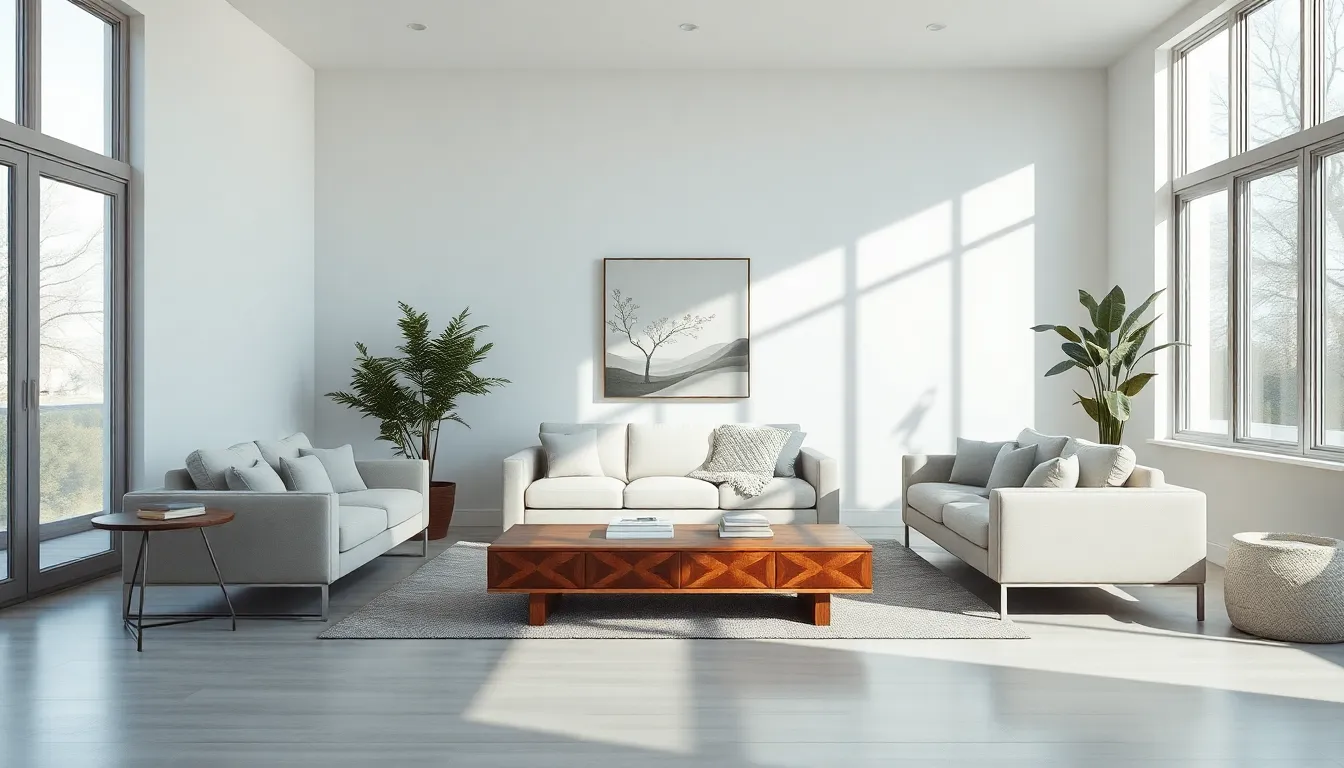In a world overflowing with clutter and chaos, minimalist design swoops in like a superhero, saving spaces from the clutches of excess. It’s not just about throwing out half your belongings; it’s a lifestyle choice that screams simplicity and elegance. Imagine a serene environment where every item has a purpose and every line tells a story. Sounds dreamy, right?
Table of Contents
ToggleWhat Is Minimalist Design?
Minimalist design emphasizes simplicity and functionality. This approach often involves stripping away unnecessary elements to create a clean and uncluttered environment. Characteristics include neutral color palettes, open spaces, and intentional design choices that enhance overall aesthetics.
Organizations adopt minimalist design to improve focus and productivity. By reducing distractions, they create spaces that foster creativity and calmness. Many designers believe this clarity promotes a deeper connection with the surrounding environment.
Furniture in minimalist settings features sleek lines and multifunctional capabilities. Each piece serves a specific purpose, reflecting the overall philosophy of utility and beauty. Artwork tends to utilize negative space effectively, allowing viewers to appreciate it without overwhelming the senses.
Minimalism also extends to digital environments. Websites and applications embrace clean interfaces, prioritizing user experience and ease of navigation. By eliminating visual clutter, designers guide users toward essential content and actions.
In residential spaces, minimalism encourages thoughtful selections regarding decor and furnishings. Individuals focus on quality over quantity, investing in items that resonate personally. The resulting atmosphere invites tranquility and promotes mindful living.
Overall, minimalist design seeks to inspire intentionality in all aspects of life. Its principles encourage individuals to evaluate their belongings, aiming for a curated experience filled with meaning and function.
Key Principles of Minimalist Design

Minimalist design embodies simplicity, functionality, and aesthetic appeal. By focusing on these principles, it creates environments that promote calmness and clarity.
Simplicity
Simplicity stands at the core of minimalist design. It emphasizes removing unnecessary elements, allowing essential features to shine. Clean lines and uncluttered spaces foster a sense of order. With neutral color palettes, rooms breathe, encouraging relaxation. Every choice reflects intentionality, ensuring that each item holds meaning. This approach transforms overwhelming environments into serene retreats.
Functionality
Functionality drives minimalist design in practical and purposeful ways. Each piece of furniture serves a dual purpose, maximizing utility without sacrificing style. Think of a table that doubles as storage, enhancing space efficiency. Minimalism values quality over quantity, promoting long-lasting materials that withstand time. Additionally, designs strive to eliminate distractions, facilitating focus and productivity in workspaces. Ultimately, this principle creates environments conducive to both relaxation and creativity.
Aesthetic
Aesthetic appeal creates a striking visual experience in minimalist design. Negative space plays a significant role, drawing attention to focal points in a room. Artwork and decor evoke emotion while being unobtrusive, enhancing overall harmony. Thoughtful placements of items maintain balance, ensuring every detail contributes to the cohesive narrative. Minimalist spaces radiate sophistication through simplicity, allowing natural light to interplay with textures. In such environments, beauty and functionality unite seamlessly, inviting tranquility.
Benefits of Minimalist Design
Minimalist design offers several advantages that contribute to a harmonious living environment. It fosters improvement in both mental clarity and aesthetic appeal.
Enhancing Focus
Clutter-free spaces enhance focus significantly. Visual distractions diminish, allowing individuals to concentrate on tasks without interruption. Productivity increases in environments where simplicity reigns supreme. Clean lines and neutral colors create a calm atmosphere conducive to deep work. By reducing sensory overload, minimalism encourages clarity of thought. Studies indicate that individuals working in minimalist settings perform better on cognitive tasks compared to those in more complex environments.
Reducing Clutter
Reducing clutter promotes a sense of serenity. By eliminating unnecessary items, one creates a serene space that invites relaxation. Thoughtful selections of decor lead to increased mindfulness regarding possessions. The emphasis on quality over quantity highlights valuable items and encourages appreciation. Dedicating space to essentials helps maintain organization and ease of movement. Minimalist design simplifies cleaning and maintenance, saving time and energy in daily routines. The result is a more streamlined living environment that fosters tranquility and balance.
Minimalist Design in Different Fields
Minimalist design proves its versatility across various fields, promoting simplicity and functionality.
Interior Design
In interior design, minimalism encourages open spaces filled with natural light. Clean lines and neutral color palettes enhance the tranquil atmosphere. Functional furniture prioritizes utility, making rooms feel spacious and organized. Thoughtful decor selections focus on quality rather than quantity, inviting a sense of calm. Examples include furniture with hidden storage and well-placed art pieces that emphasize negative space. Each element contributes purposefully to the overall aesthetic, reflecting the core principles of minimalist design.
Graphic Design
Graphic design employs minimalist principles to create engaging visual experiences. Clear layouts help convey messages effectively while reducing visual noise. Designers focus on typography, utilizing bold fonts and ample white space for readability. Elements are intentionally selected to enhance communication or storytelling. Iconography often replaces text to simplify information delivery. Users appreciate clean interfaces that allow for effortless navigation, improving overall user experience.
Product Design
Product design embraces minimalism, aiming for sleek, functional pieces. Innovative designs prioritize user needs, emphasizing usability and aesthetics. Many products feature multifunctional capabilities, reducing the need for excess items. Sustainable materials often replace traditional options, enhancing environmental responsibility. Think of products with simple lines and intuitive functions; each detail contributes to ease and efficiency. This approach not only appeals visually but also encourages thoughtful consumption.
Embracing minimalist design can transform spaces and lives by fostering clarity and purpose. This approach not only simplifies environments but also enhances focus and productivity. By prioritizing functionality and aesthetic appeal, minimalist design creates serene settings that invite mindfulness and tranquility.
Whether applied to interiors or digital platforms, the principles of minimalism encourage intentionality in choices. Each element serves a distinct purpose, contributing to a cohesive narrative that resonates with users. As individuals seek balance amidst the chaos of modern life, minimalist design stands out as a powerful tool for cultivating simplicity and elegance.


